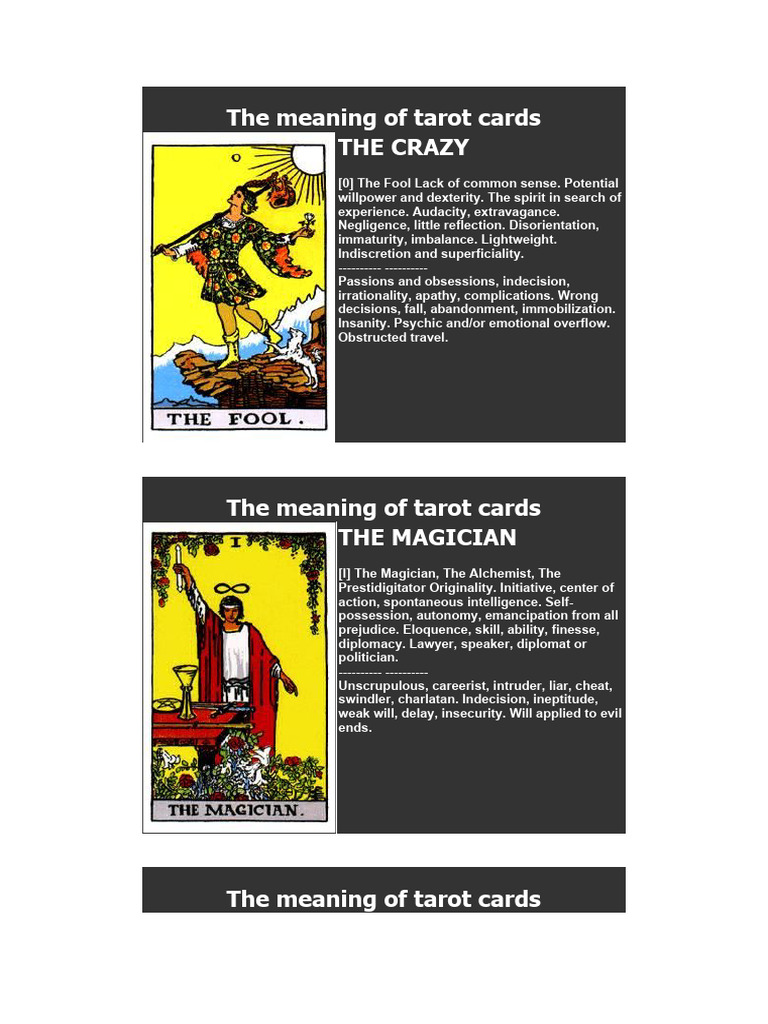Tarot cards have fascinated individuals for centuries, serving as windows into the enigmatic realms of spirituality, self-reflection, and divination. Each card is imbued with intricate symbolism and rich historical significance, which allows it to convey multiple layers of meaning. But have you ever pondered the profound stories hidden within the images that grace the tarot deck? How does each slice of imagery connect with human experience and aspiration, and could it challenge you to confront your inner landscape?
To embark on this exploration, it’s essential to familiarize ourselves with the essential components of a tarot deck. Traditionally, a tarot deck consists of 78 cards, divided into the Major Arcana and Minor Arcana. The Major Arcana comprises 22 cards, each representing significant life themes and spiritual lessons. In contrast, the Minor Arcana, consisting of 56 cards divided into four suits—Cups, Pentacles, Swords, and Wands—focuses on everyday experiences and practical matters.
Let’s delve deeper into the captivating imagery and meanings of the Major Arcana cards first.
The Fool (0)
The Fool, often depicted as a carefree figure, teeters on the edge of a cliff, blissfully unaware of the potential dangers that lie ahead. This card symbolizes new beginnings, spontaneity, and a leap of faith. It challenges us to embrace uncertainty and to trust the journey ahead, even if it feels daunting.
The Magician (I)
In the company of elemental symbols, The Magician stands poised, channels, and manifests energies to create his reality. The card speaks to the idea of manifestation and creativity. The playful question here is: what skills and resources do you possess that remain untapped?
The High Priestess (II)
Bathed in moonlight, The High Priestess offers an invitation to delve deeper into intuition and the subconscious mind. She embodies mystery and hidden knowledge. Engaging with this card encourages introspection, urging one to explore truths that lie beneath the surface.
The Empress (III)
Often depicted amidst lush gardens, The Empress radiates fertility, abundance, and nurturing energy. This card invites individuals to cultivate creativity and embrace the richness of life’s experiences. It poses the challenge: how can you foster growth in your life and those around you?
The Emperor (IV)
The Emperor, representing authority and stability, often appears seated on a grand throne. His message revolves around responsibility, structure, and leadership. It forces us to ask ourselves: are we taking charge of our lives or allowing external forces to dictate our path?
The Hierophant (V)
Symbolizing tradition, spiritual guidance, and conformity, The Hierophant is depicted as a wise figure, guiding seekers through sacred rituals. This card encourages individuals to reflect on the lessons of tradition and consider how they shape personal beliefs and values.
The Lovers (VI)
Featuring two figures entangled in a divine connection, The Lovers card speaks to the themes of love, partnership, and choices. It prompts us to ask: are you making decisions aligned with your heart, or are you swayed by external expectations?
The Chariot (VII)
Symbolizing victory and determination, The Chariot illustrates a figure in a chariot, conquering obstacles with sheer will. This card is a reminder that triumph requires focus, control, and ambition. It nudges you to consider: what are you working towards, and what challenges must you overcome to reach your goal?
Death (XIII)
Often misinterpreted, the Death card symbolizes transformation and change rather than a literal demise. It represents the closure of one chapter and the rebirth of another. This poignant imagery encourages introspection: what aspects of your life require letting go to invite new beginnings?
The World (XXI)
Anchored by the unity of all elements, The World signifies completion, fulfillment, and a sense of interconnectedness. It represents the successful conclusion of a journey. Ask yourself: how have your past experiences shaped your current reality, and how can you celebrate your accomplishments?
Transitioning to the Minor Arcana, the four suits each carry distinct stories and symbols reflecting daily life experiences. Each suit includes numbered cards from Ace to Ten, accompanied by four court cards: Page, Knight, Queen, and King, each representing various personal qualities.
Cups
This suit epitomizes emotions, relationships, and connections. The imagery often features elements of water, illustrating the flow of feelings. Significant cards include the Ace of Cups, representing new emotional beginnings, and the Ten of Cups, symbolizing ultimate happiness and family harmony.
Pentacles
The suit of Pentacles encompasses material concerns, financial issues, and the physical aspects of life. The imagery often recalls earthy elements, representing stability. Notable cards include the Ace of Pentacles, heralding new financial opportunities, and the Ten of Pentacles, depicting legacy and wealth.
Swords
This suit embodies intellect, conflict, and mental challenges. The imagery often reflects the sharpness of the mind, featuring swords piercing through obstacles. Key cards include the Ace of Swords, symbolizing clarity of thought, and the Ten of Swords, indicating the end of a tumultuous situation.
Wands
The Wands suit conveys creativity, ambition, and action. The imagery showcases fiery motifs, representing energy and movement. Important cards within this suit include the Ace of Wands, signifying inspiration and new ventures, and the Ten of Wands, which often indicates the burdens of responsibility.
In conclusion, the tarot presents a tapestry of images that not only tell stories but also challenge individuals to reflect on their lives. The questions posed through each card push one to explore depths of self and navigate the complexities of human existence. As you engage with the tarot, consider how these profound images resonate with your experiences and invite transformation. Ultimately, the tarot serves as an evolving narrative, beckoning you to weave your own tale into the fabric of its artistry.









Leave a Comment